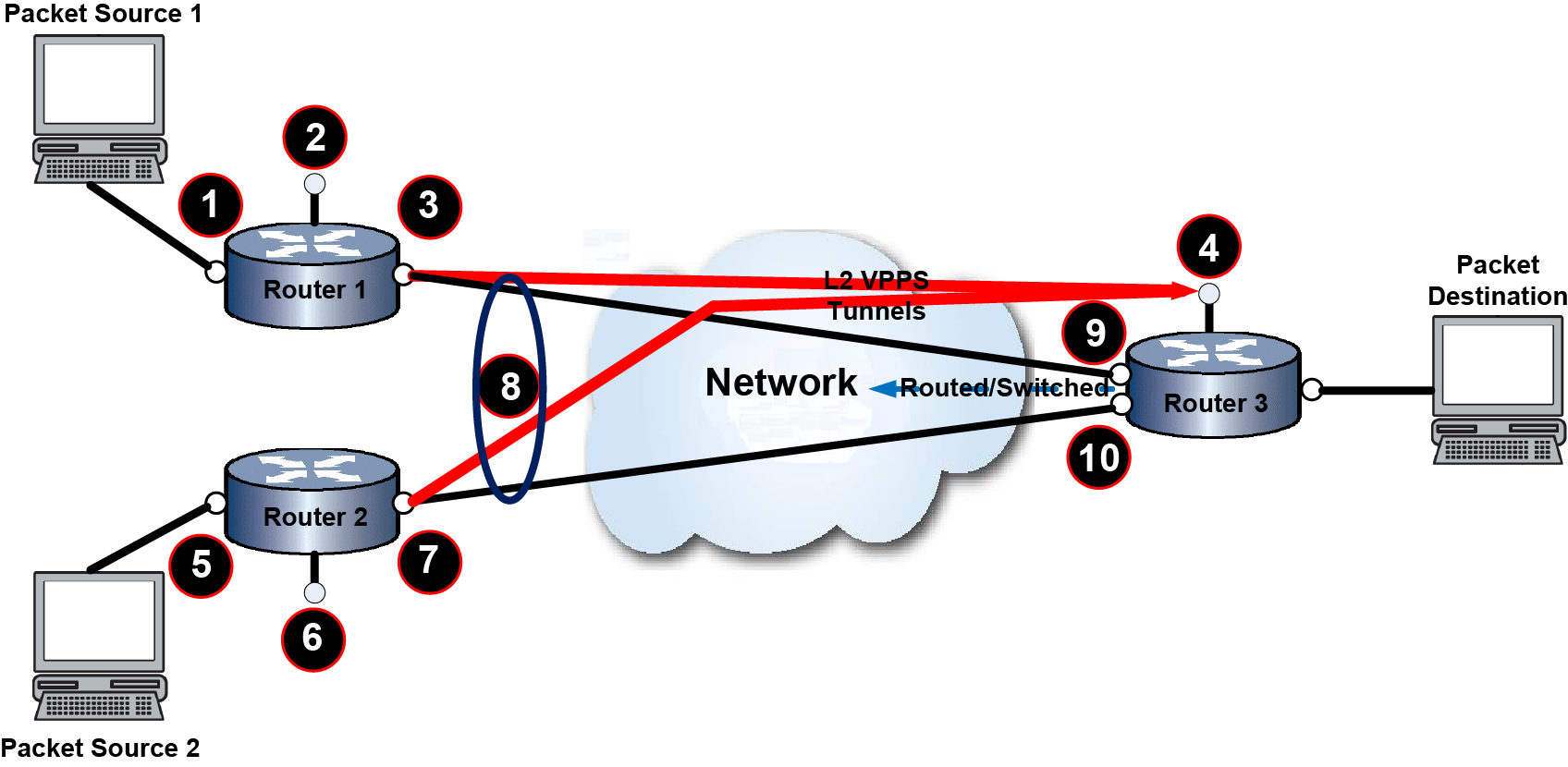Multiple tunneled port mirrors can be configured to use a single source address configured L2 tunnel (VPPS) at its destination, by configuring the destination end as an any-remote tunnel. An any-remote tunnel accepts any remote IP as the source IP address, as long as the destination IP address matches this tunnel's source IP. When any-remote is enabled on the destination end of a VPPS tunnel:
Virtual Private Port Service Any-Remote Configuration Example presents an example of an any-remote enabled L2 tunnel. In this example port mirroring is enabled on Router 1 packet sources:
Two mirror enabled VPPS tunnels (one for each mirrored source) with a single tunnel destination are created on Router1 and Router2:

| 1 | ge.1.1 – tun.0.1 Mirrored Port (Source) | 6 | loop.0.2 – tun.0.2 Source, IP Add 88.88.88.1 |
| 2 | loop.0.1 – tun.0.1 Source, IP Add 77.77.77.1 | 7 | tg.2.1 – tun.0.2 Mirrored Port (Target) |
| 3 | tg.1.1 – tun.0.1 Mirrored Port (Target) | 8 | VLAN 20 (specified in static route to tunnel destination) |
| 4 | loop.0.1 – tun.0.1-2 Destination, IP Add 99.99.99.1 | 9 | ge.1.3 – Any-Remote tun.0.1 Ingress Port |
| 5 | ge.1.2 – tun.0.2 Mirrored Port (Source) | 10 | ge.1.4 – Any-Remote tun.0.2 Ingress Port |
On the Router 3 destination side of the VPPS tunnel, an any-remote L2 tunnel is created as tun.0.1 with a tunnel source of IP address 99.99.99.1 on loopback interface of loop.0.1 (Callout 4) and a bound physical port of ge.1.3. No tunnel destination is configured and will have on affect if one is configured.
A static route with VPPS tunnel destination as its destination assures a route exists for the VPPS tunnels.
Packets from Packet Source 1 are port mirrored on port ge.1.1 and targeted to port tg.1.1 (Router1) which is the bound physical port for tun.0.1. Packets are tunneled to Router 3 loopback interface loop.0.1. Returning packets will be sourced to loopback interface 1 on Router 3, but will be decapsulated and will be switched or routed out port ge.1.3 on Router 3 to its destination.
Packets from Packet Source 2 are port mirrored on port ge.1.2 and targeted to port tg.1.2 (Router2) which is the bound physical port for tun.0.2. Packets are tunneled to Router 3 loopback interface loop.0.1. Returning packets will be sourced to loopback interface 1 on Router 3, but will be decapsulated and will be switched or routed out port ge.1.3 on Router 3 to its destination.
This example shows how to set:
System(rw)->configure System(rw-config)->interface loopback 1 System(rw-config-intf-loop.0.1)->ip address 77.77.77.1 255.255.255.255 primary System(rw-config-intf-loop.0.1)->ipv6 address 2007::1/128 System(rw-config-intf-loop.0.1)->no shutdown System(rw-config-intf-loop.0.1)->exit System(rw-config)->interface vlan 20 System(rw-config-intf-vlan.0.20)->ip address 6.1.1.1 255.255.255.0 primary System(rw-config-intf-vlan.0.20)->ipv6 address 2666::1/64 System(rw-config-intf-vlan.0.20)->ipv6 nd ra suppress System(rw-config-intf-vlan.0.20)->ipv6 forwarding System(rw-config-intf-vlan.0.20)->no shutdown System(rw-config-intf-vlan.0.20)->exit System(rw-config)->interface tunnel 1 System(rw-config-intf-tun.0.1)->tunnel source 77.77.77.1 System(rw-config-intf-tun.0.1)->tunnel destination 99.99.99.1 System(rw-config-intf-tun.0.1)->tunnel mode gre l2 tg.1.1 System(rw-config-intf-tun.0.1)->tunnel mirror enable System(rw-config-intf-tun.0.1)->no shutdown System(rw-config-intf-tun.0.1)->exit System(rw-config)->ip route 99.99.99.1/32 6.1.1.2 interface vlan.0.20 1
This example shows how to set:
System(rw)->configure System(rw-config)->interface loopback 2 System(rw-config-intf-loop.0.2)->ip address 88.88.88.1 255.255.255.255 primary System(rw-config-intf-loop.0.2)->ipv6 address 2008::1/128 System(rw-config-intf-loop.0.2)->no shutdown System(rw-config-intf-loop.0.2)->exit System(rw-config)->interface vlan 20 System(rw-config-intf-vlan.0.20)->ip address 6.1.1.2 255.255.255.0 primary System(rw-config-intf-vlan.0.20)->ipv6 address 2666::2/64 System(rw-config-intf-vlan.0.20)->ipv6 nd ra suppress System(rw-config-intf-vlan.0.20)->ipv6 forwarding System(rw-config-intf-vlan.0.20)->no shutdown System(rw-config-intf-vlan.0.20)->exit System(rw-config)->interface tunnel 2 System(rw-config-intf-tun.0.2)->tunnel source 88.88.88.1 System(rw-config-intf-tun.0.2)->tunnel destination 99.99.99.1 System(rw-config-intf-tun.0.2)->tunnel mode gre l2 tg.1.2 System(rw-config-intf-tun.0.2)->tunnel mirror enable System(rw-config-intf-tun.0.2)->no shutdown System(rw-config-intf-tun.0.2)->exit System(rw-config)->ip route 99.99.99.1/32 6.1.1.2 interface vlan.0.20 1
This example shows how to set:
System(rw)->configure System(rw-config)->interface loopback 1 System(rw-config-intf-loop.0.1)->ip address 99.99.99.1 255.255.255.255 primary System(rw-config-intf-loop.0.1)->ipv6 address 2009::1/128 System(rw-config-intf-loop.0.1)->no shutdown System(rw-config-intf-loop.0.1)->exit System(rw-config)->interface vlan 20 System(rw-config-intf-vlan.0.20)->ip address 6.1.1.3 255.255.255.0 primary System(rw-config-intf-vlan.0.20)->ipv6 address 2666::3/64 System(rw-config-intf-vlan.0.20)->ipv6 nd ra suppress System(rw-config-intf-vlan.0.20)->ipv6 forwarding System(rw-config-intf-vlan.0.20)->no shutdown System(rw-config-intf-vlan.0.20)->exit System(rw-config)->interface tunnel 1 System(rw-config-intf-tun.0.1)->tunnel source 99.99.99.1 System(rw-config-intf-tun.0.1)->tunnel mode gre l2 ge.1.3 System(rw-config-intf-tun.0.1)->tunnel any-remote enable System(rw-config-intf-tun.0.1)->no shutdown System(rw-config-intf-tun.0.1)->exit